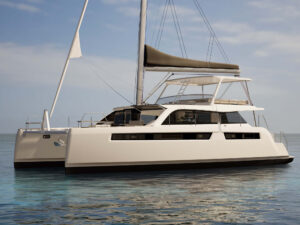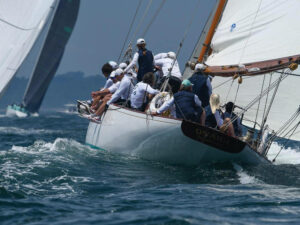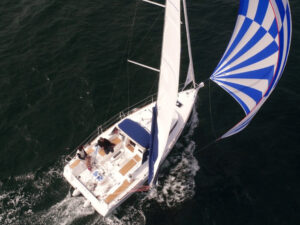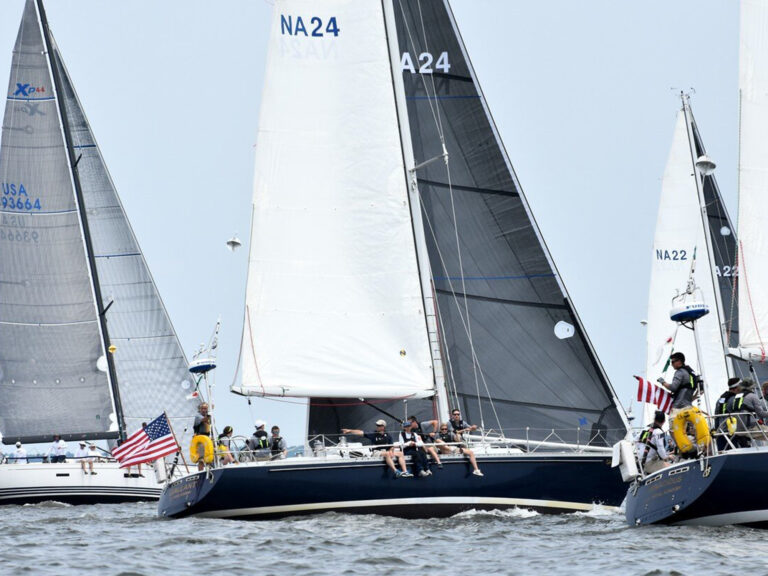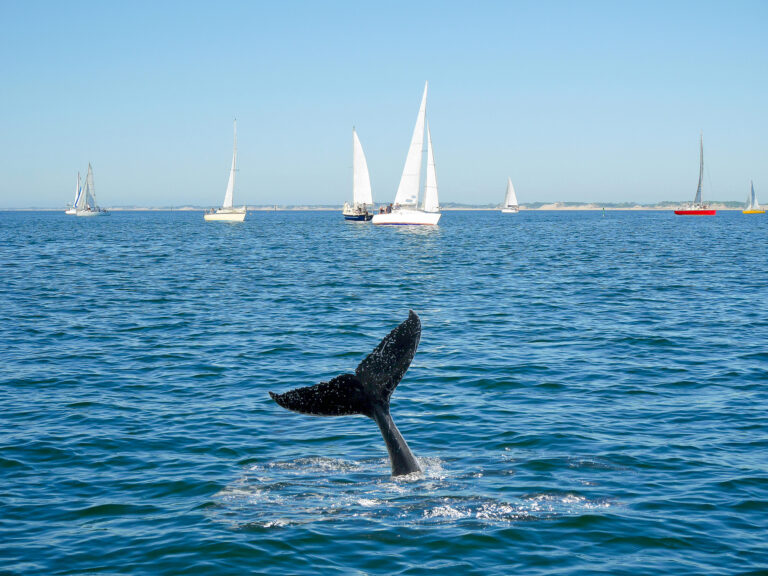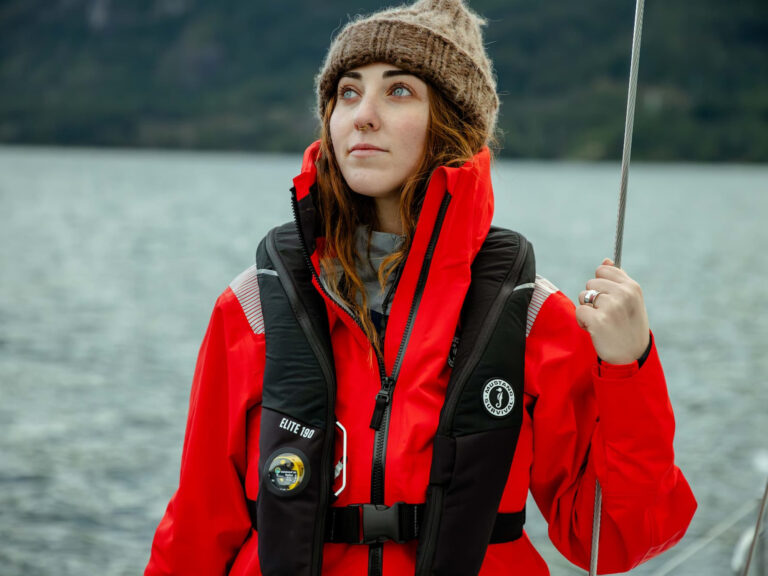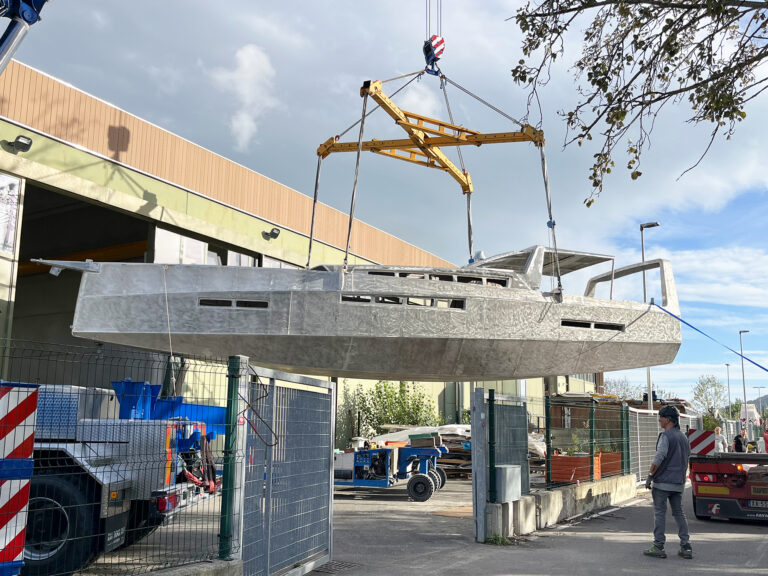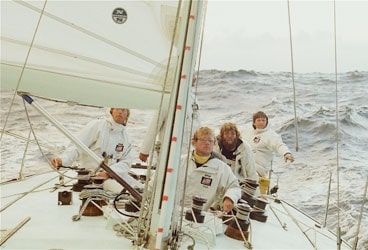
eye of the storm 368
Thirty years after a severe North Atlantic weather low struck a fleet of 303 sailboats as they approached a fabled turning mark off the south coast of Ireland, the 1979 Fastnet Race remains the mother of all storms in modern sailing lore. Shockwaves from it have affected the way races are run, the way sailors think about safety at sea, and the design and equipment found aboard boats intended for both bluewater cruising and racing. It struck without warning, a bomb that exploded on the largest fleet ever to compete for the Fastnet Challenge Cup.
Caught in the frightful nightmare of August 13 and 14, 1979, was a grand armada of some of the world’s great racing yachts, which were scattered across the Celtic Sea while climbing their way to the 605-mile race’s halfway point, the turning mark of Fastnet Rock Lighthouse, which lies four and a half miles off the southernmost coast of Ireland in an area called Mizzen Head and Cape Clear. Most never made it around the Rock that torturous night. But aboard Imp, the Ron Holland-designed 40-footer that had won the race two years earlier and was a member of the U.S. Admiral Cup team again in 1979, we pressed on, at first racing to win and then, ultimately, sailing just to survive to see our families and friends again.
The lighthouse on Fastnet Rock, first established in 1851 in cast iron, was rebuilt over a five-year period in white granite and completed in 1904. It sits on two pinnacles of hard clay shale with veins of quartz, stands 30 meters above low water, and can be an awesome, foreboding site when the weather is nasty-and it certainly was as we rounded at 0230 on August 14 aboard our little green-striped rocket ship. We’d taken a battering for the previous four hours, and conditions continued to deteriorate quickly. We were naked and raw to the elements, the rig bald-headed and triple reefed, the crew clipped in for dear life as breakers crashed over the entire lighthouse and over us. The top 15 feet of gigantic waves were breaking in great walls of water, bouncing us around like a cork in the massive, violent sea. All hell had truly broken loose, now. But I’m getting ahead of the story.
The Fastnet was first run in 1925 and had been raced generally every two years since. In the period from 1963 to 1977, conditions had been for the most part light to moderate, which no doubt encouraged sailors to eagerly enter the legendary race, which starts off at Cowes, England, on the Isle of Wight. Typically, there’s a beat out the Solent, if the sea breeze is on. Boats then head west past the spectacular Needles into open water, pass Land’s End, and sail on into the Celtic Sea, heading for the Rock. After rounding Fastnet, you can often expect a downhill reaching and running race back to a wide turn around the Isles of Scilly, 27 miles out from Land’s End, and then a dash to the finish at Plymouth, where the breeze is often quite light.
In 1979, Imp’s crew consisted of returning Admiral’s Cup veterans who’d sailed many open ocean miles together, and we trusted each other with our own lives, totally. This is sacred when it comes to going offshore.
At noon on Saturday, August 11, we waved good-bye to our girlfriends as we shoved off the docks and headed out to the Royal Yacht Squadron starting line. Hundreds of boats filled the waters, and thousands of spectators lined the shores from the Esplanade of the Squadron to as far as you could see. We got our first BBC radio broadcast for the race, predicting a sea breeze from the southwest at a solid 12 to 15 knots. Along with the rest of the fleet, we relied on the BBC forecasts for lack of anything better, but we didn’t exactly believe them. If anything, we often found the forecasts amusing. They seemed to cover all the bases. “Fair to cloudy but mostly sunny” was a typical bold offering. In this case, the outlook included a chance of showers and “possibly” winds of Force 7 to Force 8 (28 to 40 knots, or a “moderate gale”) near the Fastnet Rock by Monday, which would be Day Three.
Imp hit the starting line at full pace and in a great position relative to the rest of our fleet. We lead for several hours of racing all the way out the Solent before being passed by a couple of 70-footers, Siska and Kialoa, which had started in the class behind us. What an amazing beginning-the magic of Imp was in full bloom! But alas, it was only Chapter One of this Fastnet. At Portland Bill, the waters turned into an immense parking lot, and in effect the race started over. Rather than beat our heads into the foul current, we gave up and headed offshore to find some sea breeze. This, too, worked out well, and we were soon back in the hunt, if not actually winning, by well into Day Two as we cleared Land’s End and sailed into the Celtic Sea. It was Sunday, August 12.
We picked up the 1355 BBC weather broadcast, which again was marvelously consistent at covering the bases. This one put a smile on our collective face by predicting a complex low 300 miles southwest of Iceland and moving slowly southeast. The Fastnet Rock forecasts for the next 24 hours called for southwesterlies at Force 4 or Force 5 and increasing to Force 6 or Force 7 for a time, then veering westerly later. “Occasional rain or showers. Moderate conditions, locally poor, becoming good later.” Or, as one aboard observed, we might get some rain later, and winds might rise to a bit over 30 knots for a while, followed by clearing and softening pressure. Meantime, we believed we were winning the race.
By late on Day Three, Monday, August 13, we were in the middle of the Celtic Sea, and our heavy No. 1 genoa had been replaced by the jibtop and staysail, which we called “the double head rig” or the “pig rig.” The boat excelled with this setup, and we were close-reaching now. The latest BBC forecast indicated that we might be coming into weather more stormy than had been anticipated: “Mainly southerly 4, locally 6, increasing 6, locally gale 8, becoming mainly northwesterly later. Occasional rain, then showers. Mainly moderate with fog patches for a time.”
By 1815, forecasters predicted it to become rainy and windy, with Force 7 velocities (28 to 33 knots, a near gale) and possibly Force 8 (34 to 40 knots, a gale). This sounded challenging but harmless, as we were already pushing more than 25 knots, with a good layline to Fastnet Rock.
By dinner, the wind began to back, so the kite went up and the pig rig came down. The winds weren’t going to drop any time soon, so we dragged the No. 1 genoa below and brought up the much smaller No. 3 just in case. Now we had rising seas, irregular and confused, breaking over the deck. Temperatures plummeted. We smelled thick moisture in the air as out of the northeast there rose a gargantuan black wall of storm weather, rapidly closing. I’ve never seen anything like it. The temperature dropped another 10 degrees, and minutes later, the huge, dark wall enveloped us. As we set up to reef the main, I was struck by how much it meant to be with trusted companions. It was now blowing 30 knots, and we expected more.
With the wind building to 35 knots in the evening, we changed down to our smallest kite, the storm spinnaker, which was constructed of sturdy, 1.5-ounce fabric. We thought we could carry it, but all agreed that if we broached, we’d immediately blow the halyard, bury the kite, and put up a jib. The boat was ripping along. For the next hour, we absolutely hauled the mail, blasting ahead at 12 to 14 knots through squalls and darkness. This was balls-to-the-wall sailing. Exhilarating. Difficult. The wind kept right on building, and we knew there’d be a wipeout if we didn’t hustle and get the spinnaker down and the No. 3 jib up. Kabooom! Too late. We spun off into a wild broach and ran the kite halyard immediately. The boat bounced back up, and we scrambled to recover the chute and stuff it down the forward hatch. We were able to set and wing out the No. 3 off the spinnaker pole, with the wind now steady at 45 knots; we added a second reef in the main. By now, we were all wearing life jackets and safety harnesses. The spray and rain pelted us like bullets, and the shrieking of the wind was profoundly deafening. It was hard to see, hard even to look. You just had to pray that traffic wouldn’t appear out of nowhere. Praying was appropriate, actually. Hell was breaking loose.
At 2100, it was time to reduce sail again, to the No. 4 jib. This was an all-hands call, and each of us was aware how easily someone could be launched off the boat. To move around the deck, you had to unclip the carabiner on your harness, but first you needed a plan. You had to know exactly where you intended to hook up next and hope that those split seconds of vulnerability wouldn’t be your last. No time to be frozen by fear; just stay focused, be smart, be lucky. Several times over that hour before rounding the Rock, I was acutely aware and even expected that I could or would be the victim of a freak launching overboard. That would be the end. Recovery would be all but hopeless.
Now the skipper called for a third reef in the main. It was nearly impossible to hear each other. The winds had to be at more than 60 knots, and there was no way that a reef line could be threaded through the wildly flapping leech. We dropped the main, and four of us hung on to the sail and the boom. The boat was bouncing and pitching. This was madness. We worried about breaking the hydraulic vang holding up the boom, but staying on board was the overriding concern.
Soon we set our No. 5 jib on the inner forestay. And for that, the rig lasted all of 20 minutes. In one big surge coming off the top of an unseen roller, the T-tang of the inner forestay lifted out of its mast slot, and the whole shebang was history. The sail ragged off to leeward. Three of us gathered it in, hauled it back to the cockpit, and sent it down the main hatch. Now we were in for some brutally slow going, bald-headed and making maybe 4 knots forward and 2 or 3 knots sideways. It was still extremely dangerous, and we still had to slug out another eight miles dead upwind to Fastnet Rock. We held port tack a bit too long and overstood by a quarter of a mile. We’d lost some time, but survival and not breaking the boat was the first mission.
We rounded some 200 yards to weather at 0230. The appearance of Fastnet Light stood now in stark contrast to its look two years earlier, when we’d rounded drifting. One mate later recalled the Rock appearing like something flaring out of the shadows in a horror flick, like “a monster, foreboding, from the end of the world.” For me, Fastnet Rock looked godforsaken, with white water exploding over it and the rocks below the lighthouse glinting with the menace of jagged teeth. I screamed, “Wow, what a sight!”
Around the Rock and with Imp still bald-headed, the captain called for a watch system with two people on deck for four hours and everyone else below. Winning the race now seemed a distant concern. Not to be rolled by some massive, breaking wave was the problem of the moment. We held on starboard tack after the rounding, but now we were broad-reaching while triple-reefed. We stayed with that system till dawn, generally averaging over 7 knots with shots to 14 down the waves, all while carrying hardly any sail. On watch, we stationed the second crew right on the helmsman’s shoulder, ready in a flash to jump in, add power, and help drive off the top of a wave to avoid a dreaded roundup or rollover. After passing the Rock, though, we never crashed. Almost miraculously, there never was a crossing with another vessel, nor a nearby Mayday call or a flare from souls desperate in the night. We continued to focus totally on keeping our boat together and upright.
As we sailed on, we never saw the anemometer leave the peg at 60 knots. The size of the seas wasn’t the problem. The grief was that the top 15 feet of each wave would blow off in a sheer waterfall and roll over the entire boat. The question for all of us remained when will it end? What could be happening to other boats, particularly the smaller ones?
In daylight, with a watch change coming, the call was made to get the No. 4 jib back up. With it, the speed jumped again to 7 to 9 knots, and a crewmember and I settled into our watch. We were now eight hours into the worst storm in yachting history, the seas were huge, the wind roaring, and by the light of dawn we could make out the mad sea surrounding us and battering us. The boat was performing; she was solid and pretty watertight, with just some leaking around the mast partners and a dribble through the forward hatch.
Then came the latest weather broadcast: “South to southwest veering westerly 7 to severe gale 9, locally storm 10 in Fastnet. Rain then showers. Moderate to good.”
Moderate to good! What were they thinking, drinking, or smoking? By now, all competitors had been instructed not to use the radio to transmit unless they needed immediate assistance. We could only imagine the difficulties many other boats must have had in the night just past.
As dawn spread more light, we witnessed sights we’d never seen before: a ferocious ocean with windswept white cliffs of breaking water cascading, forming again, rolling on. Swells of tremendous power and height. We felt in control and vulnerable at the same time, a speck in this grand chaos. The sea was wild. The wind had backed off to 45 knots, but the seas were the devil spawn of the 70-knot and 80-knot winds of the long, long night. Our course continued to allow us to reach up the gigantic walls of each wave and work down the backside. We focused on each new stretch of 100 yards and how to work it.
And then, over our right shoulders we spotted the biggest rise of water that any of us had ever seen. It was perhaps a mile away. We were mesmerized and terrified. We shared insights: “Oh my god!” And “Holy crap!” It looked like a tidal wave in a doomsday nightmare. “Wow, there’s another one behind it!” Closer now, the power building, and then the first mountain was on us and under us, pulling us up, up, up. Imp stayed on her feet and handled it as we climbed the wall with a handkerchief’s worth of sail and enough speed to carve a track over the mountain.
The wave didn’t break. It didn’t break! It had to have been 50 to 60 feet tall. Then the second mountain was on us. We handled that one, too, and all of us let out simultaneous blood-curdling screams of relief and amazement.
In that moment, I felt that the worst of the storm was over and done, even though the scene around us continued in tumult. Our four-hour watch was ending, and I began to ready myself to find a safe moment to unhook my harness from the stanchion and slap the stainless-steel carabiner onto the padeye near the companionway en route belowdecks. It was time to call our replacements. As they clambered on deck, we told them, “Be gentle on the helm. We don’t want to lose the rudder! Don’t look back at the monsters. Focus on what’s ahead!” I lay down in all my gear on the aft bunk, with its Dacron flaps tied up. I was asleep in about 10 seconds.
Imp, finishing in an elapsed time of 3d:23h:36m, was the fifth Admiral’s Cup boat over the line. The overall winner was Ted Turner’s Tenacious, which was among the big boats that rounded the Rock ahead of the storm and then ran wing and wing for hours; Imp finished seventh overall. This story is excerpted from William Barton’s forthcoming Legend of Imp, available in mid December 2009. Contact [email protected] for more information.


